Journal
1: Aussie Adventures 1
Journal 2: Aussie Adventures 2
Journal 3: Indonesian Escapades
Journal 4: Singapore & Malaysia
Journal 5: Langkawi, Malaysia
Journal 6: Thailand Trekking 1
Journal 7: Thailand Trekking 2
Journal 8: Indian Ocean, Maldives, & Oman
Journal 9: Oman & Yemen
Journal 10: Pirates, Eritrea, & Sudan
Journal 11: Egyptian Adventures 1
Journal 12:
Egyptian Adventures 2
Journal 13: Egypt to Israel
Journal 14: Cyprus Crossings
Journal 15: Turkish Tales 1
Journal 16: Turkish Tales 2
Journal 17: Greek Odyssey
Journal 18: Italy & Spain
Journal 19: Why Go
Cruising?
Journal 20: Airplanes are Faster
Journal 21:
Barbados
GREEK
ODYSSEY
August 8-14, 2005
-- We have departed for
the Greek Islands after a lovely 1 month adventure in Turkey. Hurray, time
to discover another country!! We battled our way up the coast to the small
island of Simi. Summer weather systems are known to produce high speed
winds called the meltemi. In a matter of minutes, a perfectly calm sea can
be whipped up into white-capping waves, your hair develops the most
unbelievable knots, and tears start streaming from your eyes. Now I think
that I have a little better idea why Odysseus’ journey took so long! For a
little better idea, check out the TMD production of “What
is the meltemi?“ in our video section.
A perfect little bay sheltered us from the worst of the meltemi. Cool and
clear aquamarine water led up to barren hillsides of stone. Dotted around
the bay were brightly painted houses draped in fuchsia bougainvillea and
built in neoclassical style. The shore was lined with colorful fishing
boats. The boats look child-size, like playthings, but the weathered
fishermen putter around like sea admirals. Now this is exactly how I
pictured the Greek islands to be!
We headed in to explore the island by hopping on the local bus. These narrow
streets were obviously not intended for buses. There must be only a foot on
ach side of the bus as we lumber down twists and turns. It looks like our
bus driver knows everyone on the island. He keeps waving, honking his horn,
while simultaneously talking on his cell phone! By some small miracle, we
arrive safely in the main harbor town. We are here to check into Greece
which means a visit to customs & immigration, the police station, and the
harbormaster. Other than that, we are free to explore this tiny island.
Simi seems to be quite the tourist destination. While we are in town, two
large ferries come roaring into the harbor to unload masses of tourists. The
harbor is surrounded by a little village tucked into the hillside. There are
churches everywhere with domed roofs painted to match the intense blue of
the Greek sky. Simi is known for its sponge divers. Years ago the young
Greek men would free dive 30-40 feet with nothing more than a pair of
goggles and a knife to collect the sponges. Today, they are fully kitted out
with scuba gear and must descend even farther. No time for relaxing strolls
down the cobblestone streets of Simi. You must always be on the lookout for
mopeds that seem to continually have tourists in their line of sight. After
morning of exploring it was time our first official Greek gyro (much like
the Turkish doners, only tastier) and it was absolutely delicious. Top it
off with some decadent ice cream and you have a happy crew.
Our next stop was the island of Yiali. Not necessarily the prettiest stop
with us anchored just outside a quarry, but great shelter from the meltemi
that was raging for the next few days. It allowed us to pop over to the
island of Niseros which is known for its volcano. According to Greek legend,
Poseidon was chasing another god called Polybotes across the Aegean sea.
Poseidon broke off a piece of Kos island with his triton and hurled it at
Polybotes. The unfortunate deity was trapped under this piece of land
creating the island of Niseros. This explains the volcanic activity of the
island which is attributed to the sighs and groans of Polybotes. We braved
the choppy seas for a 30 minute sail over to Niseros. Then we dropped our
dinghy in the water so that David, Donna, and I could explore the island
while Dave stayed on Exit Only. The small harbor was so rolly that it took
us a good 30 minutes just to find a place to tie up. We hopped on a bus tour
up to the crater of the volcano. The last time the volcano erupted was in
the 15th century. Thankfully, the volcano is dormant but still
emits fumes. We were able to hike right down into the blown-out crater. The
further one descended into the crater, the stronger the smell of rotten eggs
(sulphur) became. Pot holes in the crater were filled with bubbling mud and
crusted with yellow crystals. Here and there, steam would rise from the
ground in chaotic bursts. You kind of have to be careful where you step or
you could end up with a scalded foot. Ouch! One sore foot later, I can
officially say that I have been inside a volcano! After our volcanic tour,
we wandered the streets of Niseros. Charming houses lined narrow walkways.
Flowers spilled out of window sills. And children raced up and down the
street.
The meltemi, our tenacious foe just will not give up. We were hoping to head
further north and west as we make our way towards the Corinth Canal, but the
winds whipped up again. We were forced to divert to the island of Kos. A
fortuitous stop in my book, as we explored the birthplace of Hippocrates,
the father of modern medicine. Guess that must just be the medical
professional in me talking! Not a lot is known about Hippocrates, except for
a few texts attributed to him and a biography written by a Roman physician
nearly 200 years after his birth. Hippocrates was the first medical
professional who attributed diseases to natural and biological causes
instead of magic. That meant that diseases could be treated and cured with
natural elements, not witchcraft or magic. In Kos town, we were able to
visit the ancient agora (central meeting place for business) where in all
likelihood Hippocrates walked around with a stethoscope meeting his
patients. Hmm … maybe my imagination is getting ahead of me. They even have
a plane tree here that Hippocrates supposedly taught under (what they fail
to mention is that the plane tree only has a life expectancy of about 200
years).
The other site to visit in Kos is the Castle of the Knights. This fortress
is absolutely huge with walls that must be 6 feet thick! In order to build
such a large castle, the knights pillaged the ancient Greek ruins throughout
the city of Kos. So it is not uncommon to see Corinthian capitals and other
pieces of stone worked into the castle walls. I don’t know exactly how
to give you an idea of just how large this fortress is. Let’s just say that
it covered the area of a football stadium! The castle sits overlooking the
water towards Turkey. The castle was built in the 14th century by
the Knight’s of Saint John as a defense against the advancing Ottoman
empire. It looked fairly impregnable with its deep moat, thick outer walls,
and inner keep. The knights just weren’t counting on the earthquake in 1495
that damaged the castle!! Now the only people that the castle tries to keep
out are the tourists that swarm around the harbor front.
Ah, the meltemi has finally settled down so we are heading for points
northwest. Our itinerary is pretty much wherever the wind blows us.
The Greek Islands
& Athens
August 15-27, 2005 -- From the island of Kos, we slowly made our way
across the Cyclades. These are desolate, yet beautiful islands that stretch
across the Aegean sea. Our direction and progress was largely determined by
the meltemi winds. Every morning, we would wake up (or rather I should say
that Dave woke us all up) at 5 AM. The coast was clear with not a ripple on
the water, and we would be off for a morning of sailing until the meltemi
winds would begin to howl. Then it was time to seek shelter wherever we
could. At many small anchorages, there would be 5-10 boats squeezed into a
small bay or inlet seeking shelter from the wind. Most of these boats were
charters which generally meant that the people on board didn’t have a clue
about sailing or anchoring a boat. It could make for some hilarious, but
also frustrating moments. Charterers would come zooming into the peaceful
cove we had found, drop their anchor without looking to see if the
anchor was holding, hop into their dinghy and zip over to the taverna
restaurant, then return to their boat for drinks and blast techno music into
the wee hours of the morning!! In our month and a half in the Med, we have
learned that the Italians seems to be the most intrepid charterers. Their
sailing and anchoring skills may not be the best, but they sure know how to
party! At one particular anchorage, there was a charter fleet of 10 Italian
sailboats (approximately 60-80 people). Somehow or another they managed to
use every inch of useable space our small bay. Then they all headed for the
beach where they had a lively game of tug-of-war!
Hopping across the Greek islands, we stopped at Levitha, Amorgos, Paros, and
Kythnos. Of these islands, Paros was probably my favorite. It perfectly fit
the picture of the Greek islands that I had in my head. A bustling little
seaside town framed by small fishing boats with a backdrop of steeples,
colorful shuttered windows, narrow streets, and small shops. I am really
starting to admire the Greek sense of style. Although their homes are simple
in construction, they pump up the charm with delicate lace curtains,
shutters and doors painted in vibrant colors, blossoms exploding over
windows and fences, and cheerful tables and chairs that beg for you to sit
in them. The prettiness of the town has made it quite popular with tourists,
so there were ferries cruising in and out of the harbor at all hours of the
day. David and I wandered all over the town exploring the different
neighborhoods, discovering the remains of a Frankish castle, visiting a
small church overlooking the ocean, pressing our noses against the window of
the pastry shop, and enjoying a yummy gyro!
Well, from the Cycladic Islands, we headed towards mainland Greece --
Attica. Nearing the headland, we were greeted by the Temple of Poseidon
sitting high on an outcrop overlooking the Aegean Sea. It was an encouraging
site for ancient mariners to glimpse this huge white temple glistening
across the sea. We were able to anchor just underneath the temple and then
hike up to it. The temple was built in 444 BC. It was destroyed during the
Persian invasion and then rebuilt with fortress like walls around it. Over
the years the temple tumbled and collapsed from earthquakes and invasions,
only to be rediscovered by tourists in the 19th century. All that
is left of the temple now are a few large columns and the foundations. They
say that Lord Byron was so moved by the sight of the temple that he composed
a poem. And somewhere on one of the columns you can even find his handiwork.
From the Temple of Poseidon, we headed for the island of Aegina. This island
is home to thousands of Pistachio trees. Only 20 km from Athens, we made
Aegina our base for a trip into the city. David and I had our own little
adventure on the side into Athens since Dave and Donna had already visited
the city a number of years ago. It ended up being one of our most expensive
days in a long time. From Aegina, we hopped on the local bus to the ferry
station at 7 AM. We arrived just in time to see our ferry depart!! So we
opted to take the hydrofoil instead!! What an amazing ride, zooming across
the water at 40 MPH!! A mere 40 minutes later we swooped into Piraeus,
Athens main harbor. It was choked full of cruise ships, ferries, hydrofoils,
fishing boats, and cargo ships. Up ahead of us rose the city, already under
a layer of haze and smog despite the early hour. Navigating Athens was a
breeze! They have a great new metro system completed in time for the Olympic
Games. On the way into the city, we were even able to glimpse one of the
Olympic stadiums. I shudder to think what the city must have been like with
the Games in full swing … crowded streets, packed restaurants, annoying
vendors!
Once we got into the heart of the city we made a beeline for the Acropolis.
A city of a hill whose light cannot be hidden. It sat perched on a high
plateau overlooking the modern city of Athens. One could say it looked like
an island of antiquity surrounded by yellowish haze. It was a bit of a hike
up to acropolis via narrow streets lined with restaurants. Strangely enough,
some of the signs for the Acropolis lead directly into a restaurant! Even
though it was still fairly early in the morning, there were crowds at the
Acropolis. Greek, Italian, French, English, German, Dutch, Japanese, Russian
…
The Acropolis has been a city for over 3000 years and a center for
philosophy, literature, drama, art, and religion. According to Greek
mythology, the gods of Olympus decided that the city should be named after
the god who could produce the most valuable gift for humanity. Athena
produced an olive tree, symbol or peace and prosperity. Poseidon struck the
ground with his trident and created a horse, symbol of strength and
fortitude. The gods proclaimed Athena’s gift would best serve the Athenians,
and so the city became Athens. During the Golden Age (4th century
BC), Athens became the pet project of Pericles who beautified the city in
with many of the monuments that are there today. The Acropolis was the
religious heart of Athens with multiple temples and also a large treasury
that held all the wealth collected from temples across Greece. Over the
centuries, the Acropolis has been destroyed and rebuilt a number of times.
The city endured foreign invasion, earthquakes, fires, archeologists, shoddy
renovation attempts, and tourists. I have even read that the Venetians
attacked the Turks here causing a gunpowder store to explode inside the
Parthenon!! And despite all this, the city on a hill continues to shine!
The main entrance to the Acropolis took us through the Prophylia and the
Temple of Athena Nike. Stately steps lead up to massive Doric columns and
the gate to the Panathenaic Way. The crowds here were ugly, forming a slow
and shuffling line into the city. The Prophylia was covered with scaffolding
undergoing a major renovation to correct mistakes of the past. Come to think
of it, most of the Acropolis seemed to be a major construction site. There
was scaffolding everywhere!! Unfortunately, this meant that many of the
monuments were hidden from sight. The Panathenaic Way was the main road
through the city. Every year the Athenians had a major party and parade down
this road to honor Athena. It used to be lined with beautiful marble
statues.
Next up was the Parthenon, the largest Doric temple ever completed in
Greece. Parthenon means “virgin’s apartment”. The temple housed a large 12
meter statue of Athena made out of gold, ivory, and precious jewels. The
Parthenon also served as the treasury for tribute money. Across the way was
the Erechtheion, the place where Poseidon stuck the ground to create a horse
and where Athena made an olive tree grow. A smaller temple was built here
with detailed statues of maidens used as columns. One audacious tourist step
over the barrier and started to walk all over the patio of the temple.
Within 30 seconds, whistles were going off right and left as a very chunky
monument guard ran up. She started shaking her finger at the tourist and
berating him loudly in Greek! Pretending to feign ignorance, he hopped off
the monument!
Our final stop was inside the Acropolis Museum. They have actually replaced
many of the Acropolis treasures for fakes in order to protect them from the
elements and tourists. All around the museum there were signs up indicating
“No Flash”. We couldn’t quite figure out how a flash would damage a marble
statue. But oh boy, did the museum monitors let tourists have if their
camera flash went off. David was reprimanded a number of times. We couldn’t
figure out how to turn the flash off on the camera, so we covered it with
our hands. We were greeted by “No flash, no flash” in each of the rooms we
visited. It was a little frustrating after trying as hard as you could to
get the stupid flash turned off and receiving the 10th warning of
“No flash, no flash!”
From the heights of the Acropolis we went down to the Roman and Greek
Agoras. This was where all the movers and shakers would meet for business,
administration, and social activity. Little is left now besides a column
here and an arch there. This is the place where the Apostle Paul came and
discussed Christianity with the Athenians. We visited the Stoa of Attalos, a
completely renovated monument. It was reconstructed by the American School
of Archeology. Two stories tall with 54 columns of pentelic marble, it used
to be painted blue and red. The stoa housed expensive shops where the
wealthy Athenians would come and hang out. Surrounding the Agora today is
the modern neighborhood of Plaka. Archeologists would love to tear this
whole place up and discover more remains of the ancient Greek city.
From Plaka, we headed for 2 museums -- the Museum of Greek Popular
Instruments and the National Museum of Archeology. The music museum was a
fun stop and had some beautiful instruments -- drums, bells, violins,
bagpipes, lutes, and flutes. David had a fun time listening to a wide
selection of recordings. From there it was a long walk through the Plaka
neighborhood and up to the National Museum of Archeology. What an amazing
museum filled with treasures from the Neolithic Period through the
Hellenistic Period. Statues, pottery, jewelry, frescos, mosaics …. High on
my list were the Minoan treasures with colorful frescos and gold jewelry.
Based out of Crete, the Minoan civilization reached its peak around 2000 BC,
only to mysteriously disappear 1000 years later. Some people think that the
major eruption of the Santorini volcano and ensuing tsunami may have been to
blame. The frescos only survived in bits and pieces. They were reconstituted
by archeologists who were pretty liberal in their interpretation of the
designs. Other interesting pieces included a bronze statue of a woman only
recently found in the waters off Simi Island (our first stop in Greece)
which we were not aloud to photograph. Then there were the lifelike statues
and busts which dated from the Classical Greek to Roman years, every day
items such as mirrors and door knobs, and intricately painted ceramics. All
in all, I would have to say that these people were living fairly well.
Athens was another great adventure on the side. If we had more time, I would
definitely have given the city a closer inspection. But our feet were
getting tired, it was getting late, and it was becoming just a little to
expensive to hang out in Athens much longer.
Back on the boat, we headed for the small town of Epidavros on the
Peloponnese peninsula. Donna who has been to Greece before wanted us to the
visit the world heritage site of ancient Epidavros which centers around the
amazingly well preserved amphitheatre there. They continue to use the
theatre today for Greek tragedies, Shakespearian drama, and musical
concerts. A quick ride on the local bus and we had arrived. In truth, I
would have to say that the amphitheatre was a bit of a letdown after seeing
the theatres of Ephesus and Heiropolis. This amphitheatre could only seat
14,000 people (much less than Ephesus) and it had none of the stage intact
(like what we saw at Hieropolis). Its only claim to fame was its “perfect”
acoustics. According to a popular guidebook, the acoustics are so good in
the Epidavros theatre that you can drop a coin on the center stage and it
can be heard perfectly throughout the entire audience. Needless to say,
there were a few people tossing coins about to test out this theory.
Our other excursion in the Peloponnese was to the Venetian city of Nafpoli.
In the 15-17th centuries, the Venetians had a trading empire that
spanned the Med. They had a very large presence in the Greek islands. The
Venetians built many towns and massive castles to defend their trade routes.
Nafpoli had 3 Venetian castles guarding the harbor and town. And so the
architecture is completely different from what we have been seeing in the
Greek Islands. It almost felt like we were walking through the streets of
Venice. The Palamidi castle sits high on a hill overlooking the harbor. You
have the option of either climbing the 999 steps or driving up to the top.
We opted for the less rigorous taxi ride up the hill. A marvel of military
architecture, the Palamidi fortress was divided into several separate
bastions which made it nearly undefeatable. It also served as a prison
during the Greek war of Independence. After our morning at the castle, we
spent the afternoon wandering through the town and sampled some delicious
gelato ice cream.
Well, we are off for the Corinth Canal now. We had horrible head winds early
in the morning, so we had to turn back. We made a second attempt a little
later on and made it to the canal entrance. The Corinth Canal transits the
narrowest part of Greece. The isthmus is only 3 miles wide and has been used
for hundreds of years to avoid sailing around the Peloponnese. In ancient
times, they actually would haul boats out of the water and have slaves drag
the boat across the isthmus. The Roman emperor Nero attempted to dig a canal
with 6000 Jewish slaves, but it wasn’t until the end of the 19th
century that a true canal was completed. It is the most expensive waterway
in the world!! As we waited to go through the canal, we watched cargo ships,
cruise ships, mega yachts, and sailboats transit the canal. Steep cliffs
rise up 200 feet on each side. You can see the places where there has been
erosion. On exiting, there is even evidence of the Roman attempt – a small
chapel-like structure with a statue. And suddenly, we have popped into the
Gulf of Corinth. There are rugged mountains, villages, vineyards, and
beaches on each side of the gulf. Just another 120 miles and we will be in
the Ionian Sea heading for Italy.
|
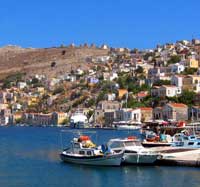
Picturesque Simi Harbor
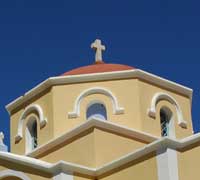
One of many Greek Orthodox churches
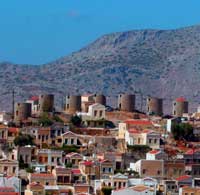
Ancient towers (maybe dovecots) line
the hillside above Simi

Say hello to the Gyro!!
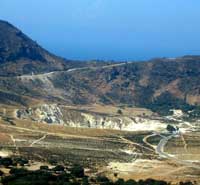
Niseros Volcanic Crater
A dormant active volcano
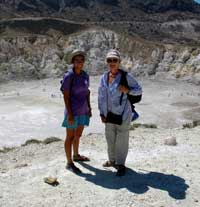
We hiked right down into the
sulphurous pit!!
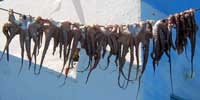
Today's Catch!!
Octopus!!
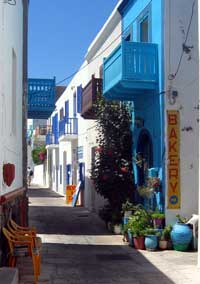
Quiet streets of Niseros town.
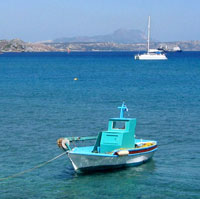
Small, but robust fishing boat at Kos.
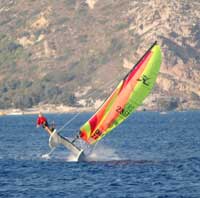
Meltemi winds make for an exciting ride!

Enjoying the view of the Aegean Sea
from Kos Castle

David takes a break from hiking
around the mile long ramparts
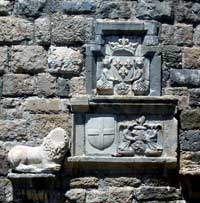
Coat of Arms for one of the
Knight's of Saint John's
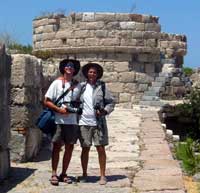
There's no place like a castle!!
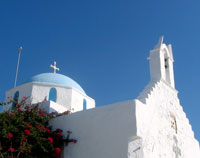
Charming white washed churches and
homes cover the hillsides of Paros
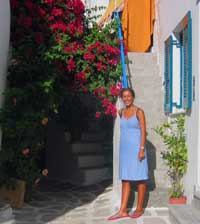
Soaking up the sun

Wandering the streets of Paros

Crowded but pretty Kythnos anchorage
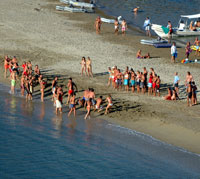
Italian charterers playing tug o'war
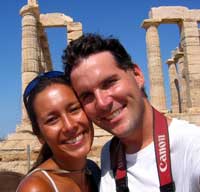
Happy hikers checking out the
Temple of Poseidon

Modern day Athens
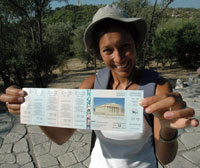
Ready to check out the Acropolis
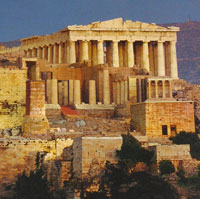
This is what the Acropolis is
supposed to look like!
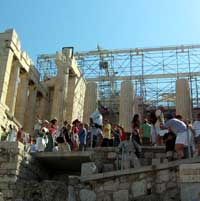
Crowds and scaffolding ...
Not quite what I expected
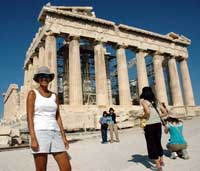
The Parthenon
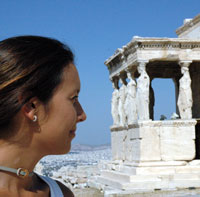
Could I pass for one of the ladies of
the Erechtheion Temple?

Famished after a day of hiking
around Athens

Relaxing in the shade of the Stoa

Hmm, how many pairs shall I buy?
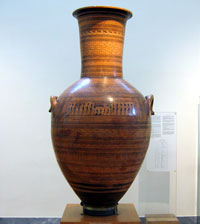
Huge funerary vase
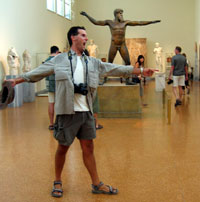
David tells me he has experience
in art modeling!?
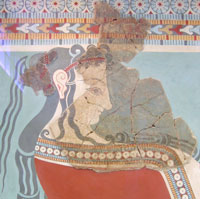
Restored Minoan fresco

Very cool looking, but what is it?
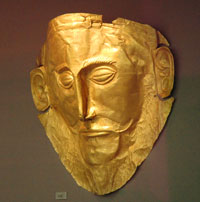
Gold Minoan death mask
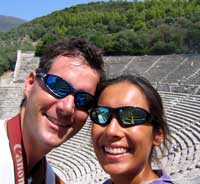
World heritage site of Epidavros

Donna & David check out the Palamidi castle
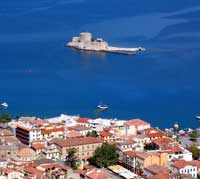
Stunning view of Nafpoli town
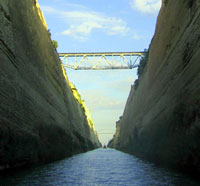
Transiting the 3 mile long Corinth Canal |

